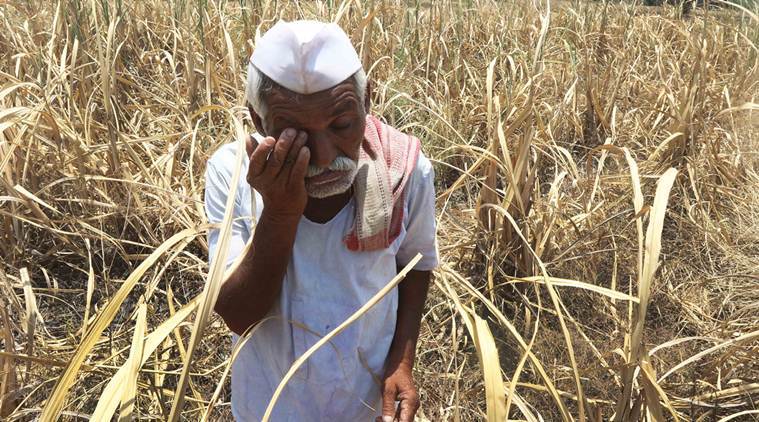Skip to content

Relevant for Sociology Essay & GS:-

- The neglect of Indian agriculture by the NDA government, despite the tall promises in the BJP election manifesto of 2014 has been the cause of untold suffering of the Indian farmer over the last four years. This has led to large-scale farmers suicides and spawned unprecedented agrarian unrest in many parts of the country. A new deal for the rural sector in general and farmers, in particular, is the crying need of the hour.
- According to Census 2011, 54.6 per cent of India’s workforce was engaged in agriculture. However, the sector contributes less than 17 per cent of the GDP. The policies of successive governments have failed to correct this imbalance.
- A report prepared by the Centre for the Study of Developing Societies, released in March 2018, based on a survey of 5,000 farm households across 18 states, revealed that 76 per cent farmers would prefer to do some other work than farming. It says that only 10 per cent of the poor and small farmers with average land holding of 1-4 acres have benefited from government schemes and subsidies. Seventy per cent of those interviewed alleged they did not get any information or advice regarding farm practices from agriculture department officials. The survey shows that 62 per cent of interviewed farmers were unaware of the Minimum Support Price (MSP). Seventy per cent had not heard about the Direct Cash Transfer scheme.
- The Indian farmer needs immediate help. Any further delay will only increase his suffering and lead to greater unrest. My recommendations, therefore, are: Farmers must receive expert advice by trained officials at their doorstep at the beginning of every crop season regarding all issues like which crops to sow, technology, market prices, soil fertility, irrigation. Agricultural extension services are almost non-existent today.
- Trade bans on agricultural exports must be removed, since such restrictive policies keep domestic prices low, harming farmers’ interests. Farmers should have free access to global markets, as it will help augment incomes. Restrictions, if any, should be imposed only in emergencies. As for domestic trade, all restrictions on inter-district and inter-state movement should be removed.
- Every farmer family must have a Kisan Credit Card (KCC). According to the NABARD, the cumulative number of KCCs issued since inception till March 31, 2015, is 14.64 crore of which operative/live KCCs are 7.41-crore. Counter-posing this against the 13.83 crore operational land holdings (Agricultural Census 2010-11) shows that a large number of farmers are yet to be covered under the KCC scheme.
- According to the Standing Committee on Rural Development, only 10 per cent of the projects taken up under the watershed development component of the Pradhan Mantri Krishi Sinchayee Yojana (PMKSY) have been completed so far.
- Rainwater harvesting should be incorporated in irrigation projects, owing to its magnificent untapped potential. I also recommend the establishment of micro, small and medium irrigation projects like tubewells and check dams, instead of big irrigation projects. Such projects should be financed entirely by the Centre.
- A “paani panchayat” should be established for every scheme, which will act as a specialised registered body responsible for the execution of irrigation projects. The panchayat will be responsible for the maintenance of water channels and collecting user charges from the beneficiaries. This will help in the augmentation of self-financing water management mechanism. It could also act as cross-panchayat body wherever applicable, for example, in cases where more than one beneficiary panchayat exists under a particular irrigation project. Every small and marginal farmer and every agricultural labourer above the age of 60 should receive a monthly pension of Rs 5,000.
- Fertiliser subsidies should be provided to the farmers via direct benefit transfer. A separate dedicated electricity line should be extended to all farmers by state governments in order to reduce their input costs and to ensure the regular supply of electricity to farms. There should be a separate category of entrepreneurs under the Mudra Yojana who will set up processing and storage plants for agricultural units.
- With low rate of interests on loans ranging from 3.5 per cent to 6 per cent, small and medium enterprises for storage and processing can aid the development of infrastructure for the agriculture sector in My most important recommendation is to immediately implement a Basic Income Scheme for the Indian farmer. The main features of this scheme will be: All small and marginal farmer households, including tenant and sub-tenant farmers, should receive a basic income of Rs 6,000 per acre per crop season. This will work out to Rs 12,000 per household per annum.
- Farmers holding land in excess of 5 acres of irrigated land, who produce disposable surplus and take advantage of the minimum support price may not be included in the scheme. For unirrigated holdings the limit could be 10 acres.
- The total financial burden of this scheme, likely to be Rs 1.84 lakh crore, could be distributed in the ratio of 70:30 between the Centre and the states. The financial burden on the Centre will thus be Rs 1.29 lakh crore, less than 1 per cent of the country’s GDP. The total expenditure budget of the Government of India in 2018-19 is Rs 24.42 lakh crore. It is therefore not difficult to find this money within the resources available to it with better expenditure management. However, even if this adds to the fiscal deficit it will be a worthwhile step because it will make the farmers happy and increase their productivity. I also recommend that there should be a one-time waiver of farmers’ loans up to Rs 2 lakh across India.
- I also suggest that all political parties should adopt this as a commitment in their manifestos in the coming Lok Sabha election. We have neglected the Indian farmer for 70 years; it is now time to make up.


